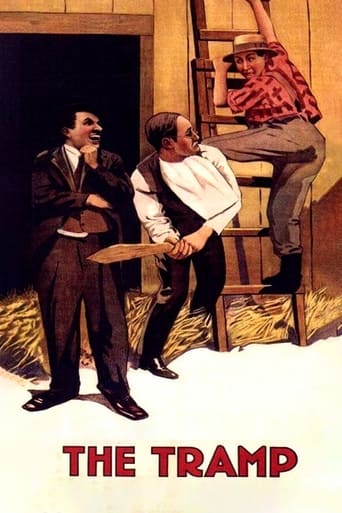Steffi_P
Were the films of Charlie Chaplin stagey because he employed long takes and few camera moves? No! There is something else you can have on screen that you can't on stage beside camera-work and edits, and that is the field of depth. From early on Chaplin had learnt how to use depth to give his little tramp character the kind of entrances and exits that you couldn't have in the theatre, ones that stretched off into the distance, allowing him to gradually appear on the scene and make the most of that now-familiar walk. In the Tramp, he created his most iconic image, that of the tramp sauntering up and later plodding away down a winding country lane.Such a great and memorable entrance is important for the more structured story lines that Chaplin was now starting to build. Whereas most of the Essanay shorts this far had simply taken a setting in which Charlie could run wild, the Tramp seems to have been constructed plot first, with the funny business appearing along the way. Far from diluting the comedy, this actually improves the material. For example, the middle section in which Charlie causes havoc on the farm, might a few months earlier have been the basis for an entire short – "The Farmhand", perhaps – but now Chaplin is able to condense the best gags of the situation down to one segment which can be woven into the overall story.The Tramp ends on a note of poignancy – something that was unheard of in screen comedy at the time. But all that Chaplin is doing is recognising something that has been established for centuries. Shakespeare knew it, and so did Dickens. Tragedy affects us more when it appears amongst comedy, and the moment that Chaplin creates here is touching and bittersweet. He even throws in one last gag to stop the moment from becoming too strained.This isn't quite the funniest of Chaplin's Essanay pictures, but it is the first mature and truly beautiful thing he had yet created.And finally, that all important statistic – Number of kicks up the arse: 5 (2 for, 1 against, 2 other)
CitizenCaine
Chaplin edited, wrote, directed, and starred in this film, a milestone for Chaplin and perhaps film comedy. It was not his first appearance as the tramp, but it was certainly his first appearance as the tramp that everyone still recognizes today. Gone is the aggressive Chaplin of old, always scheming and trying to put one over on people. Here he has a chance to do just that early in the film and chooses not to. It's as if Chaplin recognized his chance to branch out in another direction. He saves Edna Purviance from thieves and goes to her father's farm where he is given a job. Comical mishaps ensue with a pitchfork, and the tramp is not cut out to be a farmhand. The thieves return and are run off with the tramp's help, but the tramp is accidentally shot in the confusion. He eventually recovers thinking he'll marry the farmer's daughter, but he finds out she has a beau already(Lloyd Bacon, the Warner Brothers director). The tramp writes a goodbye letter and leaves. The film is consistent in tone and well edited. As in most of Chaplin's better films, the slapstick is reined in in favor of a plot or story. The ending with its simultaneous pathos and optimism is a Chaplin trademark. **1/2 of 4 stars.
mmmuconn
`The Tramp' is significant for establishing Chaplin's working-class character in the popular consciousness, but it lacks the ingenuity and surprise of Chaplin's later films. The tramp's trademark appearance and mannerisms became universally beloved, but they are not what made Chaplin great. His genius is in his vision of how to use filmmaking techniques to confound and endear his audience. Here, the closest he comes is when he devises umpteen ways to tell a joke using a pitchfork. Many of them just aren't that funny.Rating: 5.5
caspian1978
Charlie Chaplin's The Tramp will appear in his movies for the next 25 years
as America's favorite movie star. More than just a comical character.
Chaplin creates his own world, but reacts to events. He belongs to the 19th
century in his ideas. But in the early 20th century, in his films, he plays
the little man against the malevolent odds. The outsider fighting
oppressive
villains. He was the comedy of expression, specializing in minute
perfection
and precision. He alternated comedy and evoked pity and compassion.The Tramp symbolized a certain class in early 20th century
society.


 AD
AD



